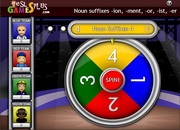Different types of clouds and how to recognize them – Science Game
This science game helps children practice different type of clouds .A cloud is a visible collection of liquid droplets, crystals frozen in time, and other particles suspended in space. Droplets can be made of water or other liquids, while crystals could contain various chemicals. These particles are known as aerosols. These particles may also possess other properties. This article will discuss several types of clouds and how to recognize them.
Stratus clouds
Stratus clouds are thin cloud structures that appear in the atmosphere. These clouds are common over hills and near the sea. These clouds are an example of adiabatic cool. Stratus clouds can be distinguished from fog clouds because of their opacity or ability to absorb sunlight. Because stratus clouds block sunlight, they can be extremely white near the solar disk.
Although stratus clouds can create interesting lighting conditions for film, their constant appearance can make them dull to view. These low-lying clouds are used by filmmakers to create atmospheric backgrounds. Many people find them boring. However, stratus clouds can be quite interesting when they are scattered among other clouds. These clouds can be a sign of bad weather ahead. If you're looking for something to do with your evenings, stratus clouds might be the perfect choice.
In calm conditions, stratus clouds can form when moist air rises over cold surfaces. Rising air causes low pressure and humidity to increase, which can be visible as fog or cloudy. If they are sufficiently thick, stratus clouds can also be accompanied with light drizzle or snow.
Although stratus clouds do not grow vertically and are quite shallow, they are susceptible to dynamic lifting. Relative humidity and uplift zones influence the region where stratus clouds form. These two elements should be correlated with the optimal conditions for each. This creates a stunning skyline with layered stratus clouds.
The stratus clouds are between the surface of the cloudy air and 2,000 feet in height. Their bases can reach as high as 4,000ft. They can cause significant precipitation in mountainous and coastal areas, particularly when thick stratus clouds form.
Two types of stratus cloud can be classified in terms of classification. The first is stratus nebulous. This layer has no features and produces light drizzle. The second type is stratus fractus. This is a layer of straight clouds that splits apart. Stratus fractus clouds can, however, produce light snow and rain.
Lastly, stratus clouds can also be called cumulus cloud. These clouds are very similar to nimbostratus cloud, but they have a completely different appearance. Cumulus clouds tend to be close to the ground, and don't rise very high. Stratus clouds can stay put for many days while cirrus clouds fly high and are feathery.
Clouds of Nimbostratus
These dark gray clouds are distinguished by their irregularly shaped bases. These clouds are low in the sky, and they are often associated with heavy rain or snow. Low-pressure systems traveling over the earth are often found ahead of Nimbostratus cloud formations. Their appearance as rainy clouds is due to their association with the virga, which is a feature that certain types of clouds can bring snow showers.
The nimbostratus clouds are composed of water droplets. They can form at low elevations, typically between two and four kilometers. These clouds may also contain ice and snow particles. They are more common at the middle latitudes. On SYNOP reports, they are coded CM2 They are an indicator of approaching or occluded storms. Although they are more common than other types, Nimbostratus clouds can also produce a steady amount of precipitation.
Thunderstorms are rarely associated with nimbostratus clouds. They may interact with cumulonimbus clouds, however, and be embedded in them. These clouds can be a lightning source, generating more intense downpours as well as larger droplets. However, it is not common for these two types of clouds together. They are most often found close to warm fronts. These clouds aren't associated with thunderstorms. These clouds, known as Nimbostratus clouds, are usually non-stratiform. They are made by cumulonimbus cloud.
When warm, moist air is slowly lifted over large areas, nimbostratus cloud formation occurs. This air is lifted slowly over longer periods in warm-fronted regions. The warm front slows down and forms a thick layer. This cloud layer provides the perfect conditions for formation of nimbostratus. It can also cause snow and precipitation. This type of weather is dangerous in winter.
The two types of Nimbostratus clouds can be classified differently. They are, however, very similar in appearance. They are very similar in appearance. The visual appearance of each type is different. One type can bring rain almost every time it appears in the sky while the other rarely brings rain. You must therefore know the relationship between cumulonimbus and nimbostratus cloud.
Altostratus is another type of cloud. It has a low level of large particles. They look almost like ground glass. They cover a lot of the sky. They may resemble fish scales. Although cirrocumulus cloud are usually small, nimbostratus cloud can look like a fish's scale.
The atmospheric conditions are also important in determining the cyclogenesis and wave-clouds of nimbostratus cloud. They occur when the temperature or relative humidity changes. This cloud is a precursor to severe weather conditions. The cyclone-like particles over the mountains can be called Nimbostratus clouds.
Lenticular clouds
The troposphere is the lowest part in the atmosphere and is where most lenticular clouds form. They are symmetrical and resemble a saucer or lens. They align in the same direction as the wind. In the lower stratosphere, lenticular clouds can also form. These clouds take on the appearance of nacreous cloud. We will first examine the origin of this nacreous cloud formation to better understand it.
Named for their lens-shaped appearance, lenticular clouds are often formed in high winds. Because they are often accompanied by strong winds, they are believed to provide a significant temperature boost. They can also form in areas where there are mountain waves. Because they are unstable, lenticular cloud tend to form on mountainous terrain.
Lenticular clouds are often associated with hills or mountains. They can appear like huge flying saucers, or as lopsided pancake stacks. They are common in many mountain ranges. They have a unique way of forming which makes them often mistakenly misinterpreted as UFOs. They form when fast-moving air above an obstacle such as a mountain range or volcano. Their deflection causes a wave in the atmosphere downwind from the obstacle. Clouds then form within its crest.
Lenticular clouds are beautiful and you might enjoy taking photos of them every day if you live close to one. Some people even predict the weather by looking at the shapes of lenticular cloud formations.
They don't move with wind and can stay at the same place for hours. They reshape as they move upwards on the mountain wave, and then they become a new form. A lenticular cloud could indicate impending precipitation if it is currently forming.
They produce strong gusts at one spot, which signals high wind flow in the surrounding atmosphere. Lenticular cloud formations are common in mountain wave zones, and they often indicate high instability. They may be visible in your locality.











